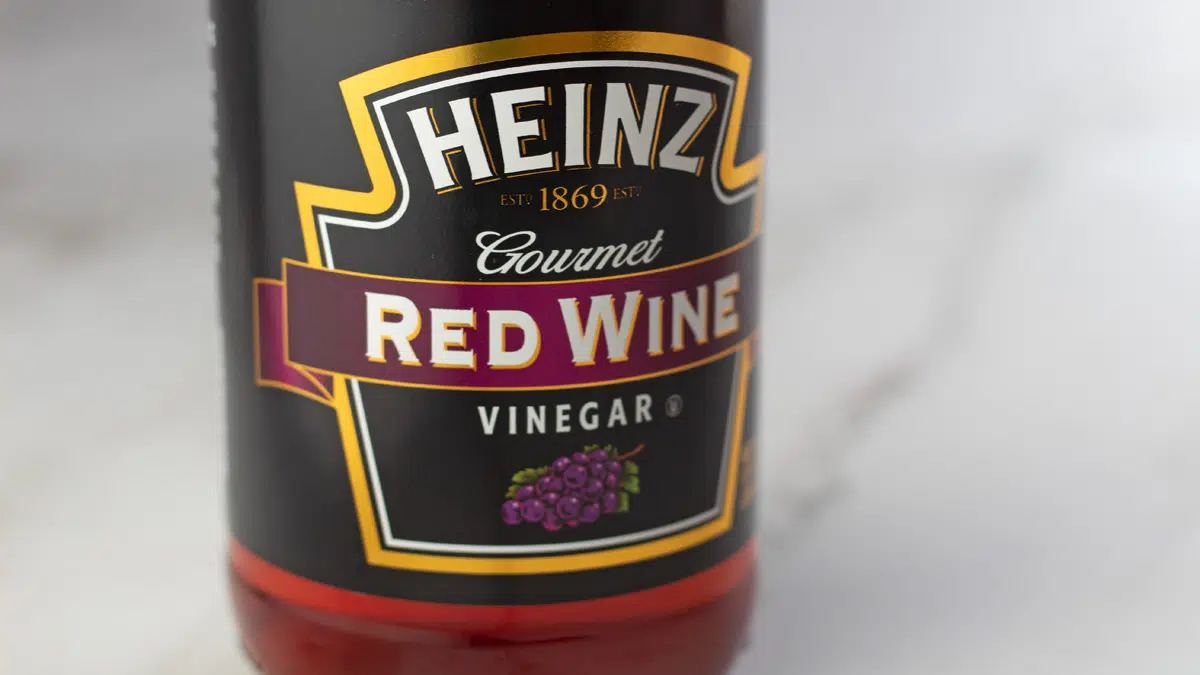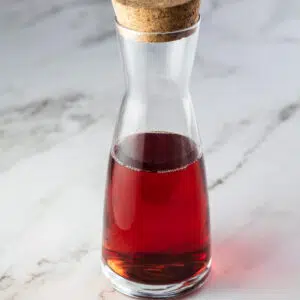9 easy Red Wine Vinegar Substitutes, plus how to make your own homemade red wine vinegar. This guide covers a variety of options, from apple cider vinegar to lemon juice, helping me find the perfect replacement for any recipe.
These substitutes ensure my dishes maintain their intended flavor without missing a beat. This comprehensive list is incredibly handy for those times when I run out of red wine vinegar.

Jump to:
- What is Red Wine Vinegar?
- 1. White Wine Vinegar
- 2. Apple Cider Vinegar
- 3. Sherry Vinegar
- 4. Rice Wine Vinegar (unseasoned)
- 5. Champagne Vinegar
- 6. Lemon Juice or Lime Juice
- 7. Balsamic Vinegar
- 8. Red Wine
- 9. Red Wine with White Vinegar
- Table 1: Acetic Acid Content of Vinegars
- More Great Substitutes
- ❓ Recipe FAQs
- 📖 Recipe Card
- 💬 Comments & Reviews
I've included all of my favorite red wine vinegar substitutions for easy changes when you've run out of this flavorful cooking vinegar. Some are really easy and just a matter of changing one ingredient for another, while a few have specific notes to help you use the alternatives to make your recipe best.
Plus I'm sharing an amazing homemade red wine vinegar recipe, right down to getting started with your own mother of vinegar. Once you have this process down, you can make intensely flavorful artisan vinegar easily.
What is Red Wine Vinegar?
Red wine vinegar is a red wine that has been fermented, strained, aged, and bottled for cooking purposes. Technically speaking, red wine vinegar does contain alcohol but is far too sour and acidic to drink. Instead, it is frequently used in Mediterranean cooking, mixed with olive oil for salad dressing, marinades, and pickling.
Red wine vinegar, as explained above, is made from red wine. After the red wine is fermented and strained, it is aged for one to two years. Red wine vinegar isn't as sweet as balsamic vinegar, and instead, has a sour, acidic taste.
1. White Wine Vinegar
White wine vinegar is made from the same process as red wine vinegar, except with white wine. It is also the closest to red wine vinegar in taste and is, therefore, the best alternative if you don't have red wine vinegar.
Use white wine vinegar in a 1:1 ratio.
2. Apple Cider Vinegar
Apple cider vinegar is a great substitute for red wine vinegar but is less acidic (5% acetic acid) and has a sweeter, fruitier taste. When mixed with other ingredients, it's unlikely that there will be any major taste differences.
3. Sherry Vinegar
Sherry vinegar has more of a brown color and is less acidic and sour than red wine vinegar but is a great red wine vinegar substitute. You may need to use a bit extra to make up for the difference in acidity but start small and work your way up.
Also note that sherry vinegar is sweeter than red wine vinegar, so consider reducing other sources of sweetness that the recipe may call for.
4. Rice Wine Vinegar (unseasoned)
As mentioned above, rice wine vinegar, also called rice vinegar, is another alternative to red wine vinegar. It is less acidic, has a milder flavor, and is generally easy to find in the Asian or ethnic aisle of your local grocery store.
Specialty Asian markets may have a wider variety of rice wine vinegar for you to choose from. Be sure that you select an unseasoned variety.
Then, start with a 1:1 ratio for red wine vinegar substitution.
5. Champagne Vinegar
Champagne vinegar is a wine vinegar but has a milder, less harsh flavor with a hint of floral notes. If you are using champagne vinegar in place of red wine vinegar, you may have to add more than the recipe calls for to get the same kick of flavor.
Start with a 1:1 ratio of champagne vinegar to red wine vinegar, then add more to taste.
6. Lemon Juice or Lime Juice
Lemon juice and lime juice have citric acid, compared to the acetic acid of wine vinegars, but can be used in place of red wine vinegar. Squeezing a small amount of juice from a fresh lemon or lime will add a dynamic acidic burst that you may love even more than red wine vinegar.
7. Balsamic Vinegar
Balsamic vinegar is commonly used in Italian recipes and can be used as a substitution for red wine vinegar. It is typically sweeter and milder than red wine vinegar.
If using this alternative, start with a small amount and add more if desired. Due to the sweetness of balsamic vinegar, consider omitting any other sweetener that your recipe calls for.
8. Red Wine
If making a marinade, you can use red wine in place of red wine vinegar. Red wine won't have the same acidity as red wine vinegar, but the flavor will be similar enough that it is a decent alternative.
9. Red Wine with White Vinegar
This alternative works for both marinades and salad dressings alike. Mix equal parts red wine and white vinegar and use in a 1:1 ratio to achieve similar results as red wine vinegar.
Table 1: Acetic Acid Content of Vinegars
To best substitute for red wine vinegar, choose a comparable vinegar in both flavor and acetic acid content (as best as possible).
| Type of Vinegar | (Typical) Acetic Acid % |
|---|---|
| Sherry Vinegar | 7-8% |
| White Wine Vinegar | 6-7% |
| Red Wine Vinegar | 6-7% |
| Balsamic Vinegar | 6-7% |
| Apple Cider Vinegar | 5-6% |
| Rice Wine Vinegar | 4-7% |
More Great Substitutes
❓ Recipe FAQs
Yes! You can use apple cider vinegar as a substitute for red wine vinegar. If the recipe calls for a small amount, it's unlikely that you will notice the difference in flavor. If the recipe calls for a larger amount, you can still substitute apple cider vinegar for red wine vinegar, but you might notice a fruitier flavor.
No! Balsamic vinegar and red wine vinegar are different. Red wine vinegar is made from red wine and balsamic vinegar is made from grapes.
Soon after harvest, the grapes used for balsamic vinegar are juiced. The juice is then reduced by about two-thirds, in which the remaining liquid gets fermented and aged in wooden barrels for at least 12 years until it is the sweet, concentrated liquid that we know and love.
Yes! Rice vinegar, also called rice wine vinegar, is made from fermented rice and can be used in place of red wine vinegar. It has a mild flavor and is less acidic. Rice vinegar can be found in the Asian or ethnic aisle of many grocery stores.
White wine vinegar is the best replacement for red wine vinegar in a Greek salad, but you can also use sherry vinegar, apple cider vinegar, balsamic vinegar, champagne vinegar, or rice vinegar, or lemon or lime juice.
Do you love a recipe you tried? Please leave a 5-star 🌟rating in the recipe card below and/or a review in the comments section further down the page.
Stay in touch with me through social media @ Pinterest, Facebook, Instagram, or Twitter! Subscribe to the newsletter today (no spam, I promise)! Don't forget to tag me when you try one of my recipes!
📖 Recipe Card
Red Wine Vinegar Substitutes + Homemade Vinegar Red Wine Recipe
Ingredients
- ½ cup red wine mother of vinegar
- 750 ml red wine (use a brand that you enjoy drinking!)
- water
(Note: 2x or 3x only changes the ingredient list)
Instructions
- Pour the red wine into a clean, wide-mouthed canning jar that can hold at least 64 ounces of liquid. Secure the lid on the jar and shake the red wine to aerate.
- Remove the lid and add enough water so that the jar is ¾ full. Add the live mother of vinegar (see notes below to make a homemade mother of vinegar, or check out the link provided to buy one that's ready to use).
- Cover the jar with a layer of cheesecloth and use a rubber band to secure the cheesecloth in place. Set your covered and sealed jar in a dark space where it can be undisturbed during the fermentation process for the next 3-4 weeks.
- Check the fermenting red wine periodically to make sure that the mother of vinegar is not growing any mold (look for black, green, or white spots - remove them this first time around, if mold persists discard the batch and start again).
- Within a few weeks, the mother of vinegar should sink to the bottom of the jar and you should begin to smell a 'vinegar' hint to the jarred contents. Taste each week to check the progression. It will take a couple of months to fully get the desired red wine vinegar flavor.
- Once your vinegar tastes satisfactory, strain it through a cheesecloth-lined plastic sieve or colander and store for use in a clean glass jar or jars. Save the mother of vinegar to make more!
Notes
- 1 liter of red wine vinegar
- 1 bottle of red wine (at least 750 mL)
- Pour the red wine vinegar into a saucepan and warm over low heat. Once heated, continue to cook at low heat for 10-15 minutes. Remove from heat and allow to cool slightly.
- Transfer the cooled red wine vinegar to a pot large enough to hold both the red wine vinegar and red wine. Add the red wine and cover the pot, then leave the mixture out in a warm spot at room temperature for 2-4 weeks.
- To check to see if a mother has formed, first make sure that you do not use any metal in the pot and that you do not HAVE ANY metal jewelry on your hands.
- Pour the red wine vinegar carefully through a plastic colander or sieve into a non-metallic bowl. If you have a gelatinous membrane (or film) remaining in the colander and your strained liquid tastes like red wine vinegar, you've got it!
- Store your mother of vinegar fully immersed in vinegar in an airtight glass or HDPE (High-density polyethylene) plastic container. These can last virtually forever! Or, start your next batch of homemade red wine vinegar!
Your homemade red wine vinegar can be stored for up to a year but will become milder in flavor as it ages.



Comments
No Comments